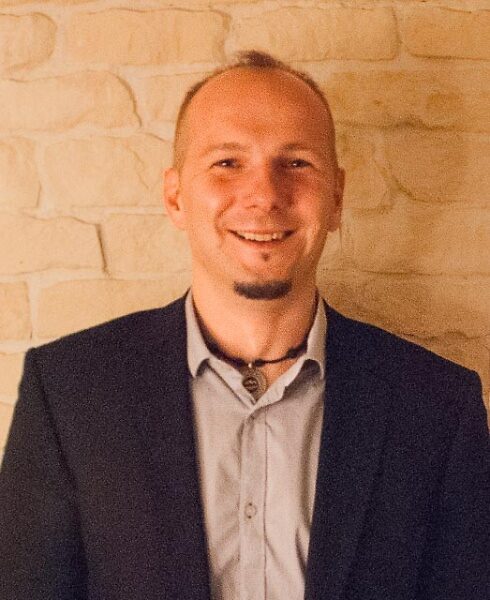"Exploiting collective dynamics for quantum optomechanics, metrology and transport applications" Dr. Claudiu Genes

Date
Location
Description
Dr. Claudiu Genes
Senior Scientist, Institute for Theoretical Physics
University of Innsbruck
Abstract
I will discuss recent/current theoretical proposals aimed at designing, enhancing and exploiting light-matter interactions in systems ranging in size from the micro-scale [quantum emitters (QE): atoms, molecules, Rydberg atoms] to the macro-scale (solid-state based mechanical resonators). The goal is to provide novel ideas for basic science and applications that exploit collective dynamics in order to outperform applications designed for single element systems.
In optomechanical (OM) systems a long-sought goal is the reach of the strong single photon-phonon coupling limit where the light-matter coherent dynamics are much faster than the relevant dissipation timescales (cavity decay rates, heating rates etc). Multi-element OM systems, where a single optical mode field permeates through a stack of high-reflectivity membranes have been recently shown to lead to a dramatic enhancement of this coherent exchange [1]. This enables applications such as the single photon blockade or the design of a coherent OM-based light-matter quantum interface as well as the study of long-range many-body phonon dynamics [2].
In tightly-packed QE systems, collective dynamics are ubiquitous as particles are typically within radiative range of each other; coherent and incoherent collective interactions occur such as i) dipole-dipole couplings leading to transport of atomic excitons or charge in some materials, or Rydberg wave packet diffusion and ii) collective dissipation and dephasing connected to the presence of superradiant/subradiant states.
On the incoherent side, I will discuss strategies to improve laser stabilization techniques, where modified Ramsey interferometry schemes with tailored additional individual rotations can lead to enhanced frequency sensitivity [3]. Moreover, specific driving configurations can lead to effective п-pulses into energetically resolved desired target collective states exhibiting both entanglement and robustness [4].
On the coherent interaction side, I will discuss recent experimental endeavours in the Ohmori group in Okazaki, where dense ultra-cold ensembles of Rydberg atoms are investigated in the time domain via Ramsey interferometry with attosecond precision. Strong correlations are revealed and their effect onto the ultrafast evolution of the collective electronic coherence is theoretically modelled by an approach going beyond mean-field [5].
Finally, the last part of the talk focuses on the strong coupling regime of cavity QED where the typical nearest neighbour transport properties of materials are considerably altered by the presence of delocalized hybrid light-matter quantum states, i.e. polaritons. Studies of atomic-exciton enhanced transport [6] showing polynomial instead of expected exponential scaling in the presence of disorder are extended to a two-band model, that simulates realistic organic semiconductor materials showing enhanced charge transport [7].
References:
[1] Strong coupling and long-range collective interactions in optomechanical arrays, A. Xuereb, C. Genes and A. Dantan, Phys. Rev. Lett. 111, 123601 (2012).
[2] Reconfigurable long-range phonon dynamics in optomechanical arrays, A. Xuereb, C. Genes, G. Pupillo, M. Paternostro and A. Dantan, Phys. Rev. Lett. 112, 133604 (2014).
[3] Protected State Enhanced Quantum Metrology with Interacting Two-Level Ensembles, L. Ostermann, H. Ritsch and C. Genes, Phys. Rev. Lett. 111, 123601 (2013).
[4] Selective protected state preparation of coupled dissipative quantum emitters, D. Plankensteiner, L. Ostermann, H. Ritsch, and C. Genes, Sci. Reps. 5, 16231 (2015).
[5] Direct observation of ultrafast many-body electron dynamics in a strongly-correlated ultracold Rydberg gas N. Takei, C. Sommer, C. Genes, G. Pupillo, H. Goto, K. Koyasu, H. Chiba, M. Weidemüller and K. Ohmori, arxiv: 1504.03635 (in review process, Science) (2015).
[6] Cavity Enhanced Transport of Excitons, J. Schachenmayer, C. Genes, E. Tignone and G. Pupillo, Phys. Rev. Lett. 114, 196403 (2015)
[7] Conductivity in Organic Semiconductors Hybridized with the Vacuum Field, E. Orgiu, J. George, J. Hutchison, E. Devaux, J. F. Dayen, B. Doudin, F. Stellacci, C. Genet, J. Schachenmayer, C. Genes, G. Pupillo, P. Samori and T. W. Ebbesen, Nat. Mat. 14, 1123 (2015).
Biography
Research fields: theoretical quantum physics, quantum optics, (hybrid) optomechanics, quantum transport, Rydberg atoms, superradiance/subradiance, metrology
Degree: PhD in Theoretical Physics, granted in 2006 from the University of Michigan, Ann Arbor, US (advisor Prof. P. R. Berman)
Awards, grants: Ludwig Boltzmann Prize 2013 (granted by the Austrian Physical Society for “groundbreaking work in optomechanics”), FWF stand-alone project leader (2013-2016) (granted by the Austrian Science Fund)
Subscribe to the OIST Calendar: Right-click to download, then open in your calendar application.



